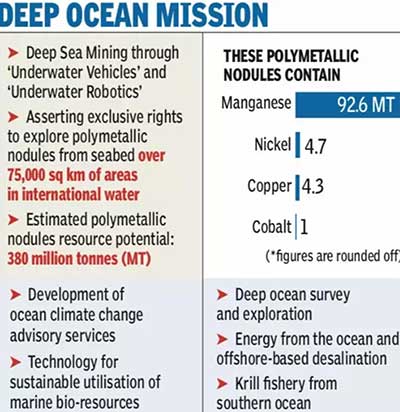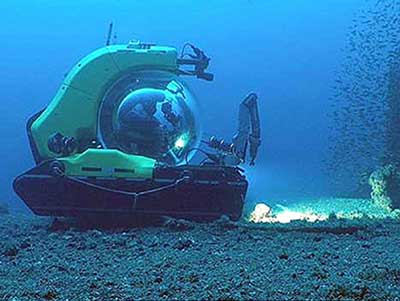Relevance: GS-3: Indian Economy and issues relating to planning, mobilization, of resources, growth, development and employment Inclusive growth and issues arising from it.
Key Phrases: Deep ocean Mission, deep ocean gliders, OCEANSAT-3 satellite, ‘Matsya-6000’, Ocean Thermal Energy Conversion (OTEC), Blue Economy Initiatives, International Seabed Authority (ISA), International Indian Ocean Expedition (IIOE)
Why in News ?
- Recently, India has plans to introduce eight deep ocean gliders having 6-12 months endurance to travel from 3,000 km to 4,500 km, about 48 deep Argo floats at 6,000-metre depth at 24 locations and another 150 wave drifters to strengthen the capacity of observations in the Indian Ocean as part of its 'Deep Ocean Mission'.
- Moreover manned submersible vehicles which can go up to 6,000 metres deep, scientific cruises to scour the ocean and also a new multidisciplinary research vessel will be launched in the next three years.
- Mission also planning to launch the OCEANSAT-3 satellite by the end of next year.
About Deep Ocean Mission:
- Deep Ocean Mission is an initiative by the Government of India to explore the deep ocean for resources and develop deep-sea technologies for sustainable use of ocean resources.
- The Mission will send a manned submersible ‘Matsya-6000’ up to a depth of 6,000 metres in the ocean with three people aboard.
- The submersible will be equipped with technologies such as scientific sensors, and tools for deep-sea mining, exploration of deep-sea marine biodiversity and mineral resources.

Do you know the six major components of the Deep Ocean Mission?
- Development of Technologies for Deep Sea Mining, and Manned Submersible.
- Development of Ocean Climate Change Advisory Services.
- Technological innovations and conservation of deep-sea biodiversity.
- Deep Ocean Survey and Exploration and Deep sea exploration of ocean resources.
- Energy and freshwater from the Ocean: offshore Ocean Thermal Energy Conversion (OTEC) powered desalination plant are envisaged.
- Advanced Marine Station for Ocean Biology. This component is aimed at the development of human capacity and enterprise in ocean biology and engineering.
Key Highlights:
- Comprehensive coverage and credible data collection:
- With the help of these in situ and satellite data of sea temperatures, currents, salinity etc., Mission is trying to predict as accurately as possible the various climatic conditions and the monsoons.
- Availability of resources and needed technologies to extract it also in the mission's pipeline.
- Ocean is key to fulfill objectives of SDG 13(Climate change) and SDG
14 (Life below Water):
- Oceans knowledge are sine qua non to understanding the climate in securing lives and livelihoods due to vast coastline.
- The ocean is at the core of ‘Blue Economy’ policy of which the ‘Deep Ocean Mission’ forms an integral part for which about ₹4,077 crore has been committed over a five year period.
- Oceans are reservoirs of resources and key to carbon sequestration:
- The deep ocean mission and its focus on sustainable utilization of the ocean will enunciate the way forward on sustainable ocean development in mining of deep sea and coastal resources, off-shore energy and climate services.
- Developing advanced technology in underwater robotics, marine stations, studying biodiversity, bio-corrosion, microorganisms, etc. will be key.

- Areal differentiation approach for studying various integrated
phenomena:
- A spatial approach for understanding interrelated complex phenomena has been identified for further research for precise observations and predictions of future cyclones, thermal ocean health through statistical and dynamic modelling and observation networks.
Deep Ocean Mission impact on Indian Economy:
- The ‘Deep Ocean Mission’ plan will enable India to develop capabilities to exploit resources in the Indian Ocean Basin.
- The Mission aims to support India’s Blue Economy Initiatives. The Mission is a multi-ministerial, multi-disciplinary program that emphasizes developing deep-sea technology, including the development of manned submersibles, the acquisition of a research vessel for exploring the ocean, and capacity building in Marine Biology.
- Mission will help in studying the Impact of climate change on the ocean. This would help India to prepare for any disaster due to climate change. Also, Oceans provide an alternate and more cleaner source of energy.
- Mission will play a significant role in the security of the nation as many critical military technologies rely heavily on rare earth elements which are abundant in Ocean.
- The Ministry of Earth Sciences has a 15-year contract with the International Seabed Authority (ISA), an UN-backed body in charge of regulations for ocean floors, to explore 75,000 sq. km in the Indian Ocean for Manganese Nodules, also known as Polymetallic Nodules.
- A preliminary study indicated 380 million metric tonnes of polymetallic nodules comprising Manganese, Cobalt, Iron, Lead, Zinc, and Copper in the Central Indian Ocean basin. These metals are estimated to be $110 billion.
Way Forward
- The objective of the mission is to bolster the deep ocean observation with more platforms and prepare a framework model for future services on how and when the cyclones and storm surges will happen, whether their numbers will increase or intensity with global warming, harmful algal bloom, coastal morphology, erosion, etc.
- Monitoring and regular assessment of the progress and scientific knowledge gained during the second phase of International Indian Ocean Expedition (IIOE) launched in 2015 must be utilised for commercialisation of resources.
- The Indian Ocean is the least studied among the oceans and there is a need for different nations located in the Indo-Pacific region to put priority for sustainable ocean planning and development.
- Sustainable Development Goal (SDG 14), calls to conserve and sustainably use the oceans, seas and marine resources for sustainable development. Thus a deep ocean mission is a right step in this direction.
Source: The Hindu, PIB
Mains Question:
Q. While the Deep Ocean Mission has been lauded for its rapid ocean resources exploration and strong synergies to Blue Economy initiatives, however it suffers from several hurdles which undermine its stated objective and aims in the Indo-Pacific region. Examine. (10 marks).









